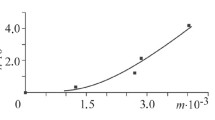Conclusions
-
1.
Cracking occurs in tubular specimens of U8 steel hydrogenated to high hydrogen concentrations mainly because the gaseous hydrogen affects the steel.
-
2.
Slow failure occurs by the formation and growth of defects of crack type, which cause the large-amplitude discrete AE signals alternating with continuous AE ones of relatively low amplitude.
-
3.
Cracking is accentuated by increased pressure during the hydrogenation at a given temperature and by reduction in the cooling time.
-
4.
High tensile steels saturated with hydrogen are liable to slow failure by the formation and growth of defects of crack type. The main periods in the failure are as follows: a) preparatory period, with plastic strain and corrosion due to the high temperatures and to the residual-stress and strain concentrations on cooling; b) the incubation period, when microcracks are formed at grain boundaries and nonmetallic inclusions; and c) subcritical growth period, where microcracks merge into macrocracks, which grow.
-
5.
The cracks grow in steps equal to the sizes of the grains or a few grains, and the AE is due to intercrystallite cracking in the zone of stable crack growth in U8 steel.
Similar content being viewed by others
Literature cited
A. E. Andreikiv and N. V. Lysak, Acoustic Emission in Research on Failure Processes [in Russian], Naukova Dumka, Kiev (1989).
V. V. Panasyuk, A. E. Andreikiv, and V. S. Kharin, “A model for crack growth in deformed metals acted on by hydrogen,” Fiz.-Khim. Mekh. Mater., No. 2, 3–17 (1987).
V. S. Kharin, “Crack growth in deformed metals acted on by hydrogen,” Fiz.-Khim. Mekh. Mater., No. 4, 9–17 (1987).
R. A. Oriani, “Hydroen embrittlement of steel,” Ann. Rev. Mater. Sci.,8, 327–357 (1978).
S. Talbot-Besnard, “Idées actuelles la mechanismes de la fragilation par l'hydrog'ene du fer et des alliages ferreux,” Deuxieme Congres International: L′hydrogéne dans les Metaux, June 6–11 (1977), Paris, pp. 3/I–3/II.
A. E. Andreikiv, N. V. Lysak, V. K. Kalenskii, et al., “Diagnosing crack growth at an alloy boundary in hydrogenated specimens,” Tekhn. Diagnostika i Nerazrushayushchii Kontrol′, No. 3, 32–36 (1990).
V. A. Gol'tsov and N. A. Ishchenko, “Acoustic emission in fragment formation in steel,” Dokl. Akad. Nauk SSSR,261, No. 5, 1122–1126 (1981).
H. N. G. Wadley and R. Mehrabian, “Acoustic emission for material processing: review,” Mater. Sci. Eng.,65, No. 2, 245–263 (1984).
M. Horiuchi, “Fractography and acoustic emission applied to evaluating the failure toughness of 4340 steel subject to mixed viscobrittle failure as result of hydrogen embritlement,” Tetsu to Hagane,67, No. 5, 420 (1981).
H. Ishizuka and R. Chiba, “Corrosive action of hydrogen on steel at high pressures and temperatures,” Sekiyu Gakkaishi,11, No. 11, 838–844 (1968).
T. Kishi and A. Nozue, “Estimating hydrogen cracking in 4340 steel from acoustic-emission signals,” Nippon Kinzoku Gakkaishi,45, No. 12, 1305–1309 (1981).
E. Kukuta, “Crack nucleation during slow failure in high-tensile steel,” Tetsu to Hagane,64, No. 4, 288 (1978).
B. S. Kasatkin and V. F. Musiyachenko, “The formation mechanism for intercrystallite cold cracks in the surrounding zone of a welded joint in work-hardened steel,” Probl. Prochn., No. 10, 3–9 (1974).
Author information
Authors and Affiliations
Additional information
Translated from Fiziko-Khimicheskaya Mekhanika Materialov, Vol. 28, No. 4, pp. 63–69, July–August, 1992.
Rights and permissions
About this article
Cite this article
Andreikiv, A.E., Lysak, N.V., Skal'skii, V.R. et al. Acoustic-emission monitoring of hydrogen cracking in metals and alloys. Mater Sci 28, 378–382 (1992). https://doi.org/10.1007/BF00723217
Received:
Issue Date:
DOI: https://doi.org/10.1007/BF00723217



